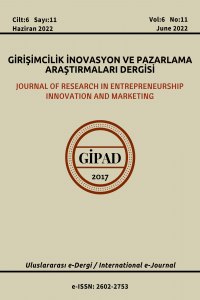Küresel Rekabet Dinamikleri Altında Müşteri Taleplerini Karşılama: PVC Masa Örtüsü Sektörü Üzerine Bir İnceleme
Yeniliği ve değişimi benimseyen, müşteri odaklı kaliteli bir hizmet sunmayı kendine misyon edinmiş işletmeler, rakiplerinin karşısında önemli bir ilerleme kaydetmektedir. Müşterinin ihtiyacına uygun yeni ürünlerin üretilmesi amacıyla Ar-ge ve Ür-ge birimlerine öncelik verip yatırımlarını bu birimlere yönlendirmektedir. İşletmelerin sundukları bu yeni ürünler işletmeye satış, karlılık ve büyüme olarak birçok noktada katma değer sağlamaktadır. Araştırmanın amacı, müşteri talebi üzerine üretilen yeni ürünün müşterinin ihtiyaçlarına uygun hale getirmek için geçirdiği üretim sürecini analiz ederek, işletmeye ve müşteriye ne şekilde katma değer sağladığını ortaya koymaktır. Araştırmanın ilk bölümünde ev tekstili sektörüne ilişkin genel bir değerlendirme yapıldıktan sonra, masa örtüsü ürün grubu ve PVC masa örtüsü üretim süreci hakkında bir bilgilendirme yapılmaktadır. İkinci bölümde, müşterinin istekleri doğrultusunda üretilen yeni ürünün üretim süreci vaka analizi yapılarak açıklanmaktadır. Son bölümde yer alan araştırmanın sonucuna göre, ürün farklılaştırması ile beraber müşterinin memnuniyeti sağlanmış, bu durum da işletmeye satış ve müşteri sadakati olarak yansımıştır.
Anahtar Kelimeler:
Ev tekstili, PVC masa örtüsü, ürün farklılaştırma, rekabet
Meeting Customer Demands Under Global Competitive Dynamics: A Review of PVC Tablecloth Sector
Businesses which have embraced innovation and change and are committed to providing quality customer-focused services, have made significant progress against their competitors. Businesses which want to have a premise in the competitive environment give preference to R&D and P&D units and direct their investments to these units in order to produce new products suitable for the customer's needs. These new products offered by the businesses are preferred by the customers and provide added value to the business as sales, profitability and growth. The aim of the research is to analyze how the new product produced on the customer's request is adapted to the needs of the customer and to show how the business and the customer provide added value. After an overview of the home textiles sector in the first part of the research conducted in this framework, information is provided on the tablecloth product group and PVC tablecloth production process. In the second part, the production process of the new product produced in line with the customer's wishes is explained by making case analysis. According to the result of the research in the last section, customer satisfaction has been provided with product differentiation, which is reflected as sales to the business and customer loyalty.
Keywords:
Home textile, PVC tablecloth, product differentiation, competition,
___
- Ama Research. (2016). Household Textiles Market Reports-UK 2016-2020 Analysis. Retrieved from https://www.amaresearch.co.uk/products/household-textiles-2016. (Erişim Tarihi:03.05.2018)
- Aybartürk, B. (2011). ‘‘Cad/Cam Tasarımından Üretim Aşamasına PVC Masa Örtüsü’’ (Yüksek Lisans Tezi), İzmir: Dokuz Eylül Üniversitesi, Güzel Sanatlar Enstitüsü, Tekstil ve Moda Tasarımı Anabilim Dalı.
- Das, S. (2010). Performance of home textiles. India:WPI Publishing.
- Durur, G. & Parer, O. (2009). ‘‘Türkiye ve Denizli’de Ev Tekstillerine Genel Bir Bakış’’, Tekstil ve Mühendis, 16 (76), 17-23.
- Güney Ege Kalkınma Ajansı (GEKA). (2015). Denizli Ev Tekstil Sektörü Analiz Raporu. Retrieved from http://geka.gov.tr/2460/denizli-ev-tekstil-sektoru-analiz-raporu-2015.
- Holmsten-Carrizo, C. (2013). ‘‘Responsible sourcing and transparency in the home textile industry’’ (Master Thesis), Sweden: Swedish University of Agricultural Sciences, Environmental Economics and Management, Master’s Programme.
- Kılıç, A. G. S., Özdemir, A. G. D. E., & Şenol, A. G. D. G. (2011). ‘‘Küresel ekonomik kriz ve ev tekstil sektörü: Pazarlama bakış açısından yöneticilerin değerlendirmeleri’’, Paradoks: The Journal of Economics, Sociology & Politics, 7(1), 67-80.
- Kim, S. H. (2006). ‘‘A study on the customer's satisfaction of the tableware on foodstyling using fuzzy cognitive maps’’, Journal of the Korean Society of Food Culture, 21(6), 571-576.
- Ozgur, H. (2005). Integration of a local economy to the global and European markets through export-led growth and specialized textile products export: Home textile production in Denizli, Turkey. Proceedings of the 18th European advanced studies institute in regional science in Lodz-Cracow, Poland.
- Pothault, M. (1997). The Book Of Fine Linen. Italy:Thames And Hudson.
- Taylor, M.C. (1972). Technology of Textile Properties. London:Billing & Sons Ltd.
- Trade Map.(2017). http://www.trademap.org, (Erişim Tarihi:03.05.2018).
- Tomita, K., Ono, M. & Kimiko, T. A. (2006). ‘‘The atmosphere of the dining produced by the various kinds of tablecloth colors under three kinds of illuminant condition’’, Journal of ARAHE, 13,173-184.
- Türkiye Cumhuriyeti (T.C.) Ekonomi Bakanlığı.(2016). Ev Tekstili Sektör Raporu. İhracat Genel Müdürlüğü, Tekstil ve Konfeksiyon Ürünleri Daire Başkanlığı. Erişim yeri https://www.ekonomi.gov.tr/portal/content/conn/UCM/uuid/dDocName:EK-224569
- Uludağ İhracatçı Birlikleri (UİB). (2017). Ev tekstili Raporu (Ar-Ge Şubesi). Erişim yeri http://www.uib.org.tr/tr/elektronik-kutuphane.html?t=Ar-Ge%2CRaporlar%2CTekstil
- Wagner, J. (1986). ‘‘Expenditures for household textiles and textile home furnishings: an Engel curve analysis’’, Family and Consumer Sciences Research Journal, 15(1), 21-31.
- Yayın Aralığı: Yılda 2 Sayı
- Başlangıç: 2017
- Yayıncı: Mehmet MARANGOZ
Sayıdaki Diğer Makaleler
Alim Fatih KILINÇ, Ceyda LALE SANCAKTAR
Kirzner’in Girişimcilik Teorisinin Avusturya İktisat Okulundaki Yeri ve Önemi
Dördüncü Sanayi Devrimi Endüstri 4.0: Dünya ve Türkiye Değerlendirmeleri
Sabiha KILIÇ, Reha Metin ALKAN
Bora GÖKTAŞ, İnci ERDOĞAN TARAKÇI
Asgari Ücret, İstihdam ve Ekonomik Büyüme İlişkisi: BRICS-T Örneğinde Bir İnceleme
